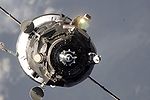
Progress-M
Encyclopedia
Progress-M also known as Progress 7K-TGM, is a Russia
n, previously Soviet
spacecraft which is used to resupply space station
s. It is a variant of the Progress spacecraft, originally built in the late 1980s as a modernised version of the Progress 7K-TG
spacecraft, using new systems developed for the Soyuz-T
and Soyuz-TM
spacecraft. The 11F61560 variant is further modernised with digital flight control systems replacing the earlier analogue ones. The older 11F615A55 spacecraft is being phased out in favour of the 11F61560, with the last launch of the older model in July 2009.
 The first forty three Progress-M spacecraft were used to resupply Mir
The first forty three Progress-M spacecraft were used to resupply Mir
, with subsequent spacecraft flying to the International Space Station
. , sixty eight spacecraft have been launched, with sixty six using the older model, and two using the newer version.
Two Progress-M spacecraft, M-14 and M-38, were modified to carry VDU attitude control systems to the Mir space station.
The Progress-M1
is a derivative of the Progress-M, optimised to carry more fuel, at the expense of dry cargo and water. It entered service in 2000, and was retired in 2004. A modernised version, incorporating the upgrades made to the Progress-M 11F61560 is scheduled to enter service in 2011.
Russia
Russia or , officially known as both Russia and the Russian Federation , is a country in northern Eurasia. It is a federal semi-presidential republic, comprising 83 federal subjects...
n, previously Soviet
Soviet Union
The Soviet Union , officially the Union of Soviet Socialist Republics , was a constitutionally socialist state that existed in Eurasia between 1922 and 1991....
spacecraft which is used to resupply space station
Space station
A space station is a spacecraft capable of supporting a crew which is designed to remain in space for an extended period of time, and to which other spacecraft can dock. A space station is distinguished from other spacecraft used for human spaceflight by its lack of major propulsion or landing...
s. It is a variant of the Progress spacecraft, originally built in the late 1980s as a modernised version of the Progress 7K-TG
Progress 7K-TG
Progress 7K-TG , was a Soviet unmanned spacecraft used to resupply space stations in low Earth orbit. Forty three flew, delivering cargo to Salyut 6, Salyut 7, and Mir...
spacecraft, using new systems developed for the Soyuz-T
Soyuz-T
The Soyuz-T spacecraft was the third generation Soyuz spacecraft, in service for seven years from 1979 to 1986. The T stood for transport...
and Soyuz-TM
Soyuz-TM
The Soyuz-TM crew transports were fourth generation Soyuz spacecraft used for ferry flights to the Mir and ISS space stations...
spacecraft. The 11F61560 variant is further modernised with digital flight control systems replacing the earlier analogue ones. The older 11F615A55 spacecraft is being phased out in favour of the 11F61560, with the last launch of the older model in July 2009.

Mir
Mir was a space station operated in low Earth orbit from 1986 to 2001, at first by the Soviet Union and then by Russia. Assembled in orbit from 1986 to 1996, Mir was the first modular space station and had a greater mass than that of any previous spacecraft, holding the record for the...
, with subsequent spacecraft flying to the International Space Station
International Space Station
The International Space Station is a habitable, artificial satellite in low Earth orbit. The ISS follows the Salyut, Almaz, Cosmos, Skylab, and Mir space stations, as the 11th space station launched, not including the Genesis I and II prototypes...
. , sixty eight spacecraft have been launched, with sixty six using the older model, and two using the newer version.
Two Progress-M spacecraft, M-14 and M-38, were modified to carry VDU attitude control systems to the Mir space station.
The Progress-M1
Progress-M1
Progress-M1 , also known as Progress 7K-TGM1, is a Russian spacecraft which is used to resupply space stations. It is a variant of the Progress spacecraft, derived from the Progress-M, but modified to carry more propellent for refuelling the space station instead of other cargoes such as water...
is a derivative of the Progress-M, optimised to carry more fuel, at the expense of dry cargo and water. It entered service in 2000, and was retired in 2004. A modernised version, incorporating the upgrades made to the Progress-M 11F61560 is scheduled to enter service in 2011.

